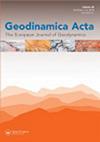沿主要走滑断裂带的钙华产状:来自土耳其东安纳托利亚断裂系统(EAFS)的构造、沉积和地球化学约束
IF 1.5
Q1 Earth and Planetary Sciences
引用次数: 15
摘要
东安纳托利亚断裂系统(EAFS)是一条宽30 km、长700 km的左旋走滑断裂带,是土耳其第二大新构造。本研究通过多学科的研究,探讨了沿该主要走滑断裂带部分段石灰华降水与构造活动的关系。对沿EAFS Karlıova-Bingöl段(KBS)和Adıyaman断裂带(AFZ)的若干石灰华产状进行了构造、沉积学、地球化学和年代学研究。AFZ上的balta本文章由计算机程序翻译,如有差异,请以英文原文为准。
Travertine occurrences along major strike-slip fault zones: structural, depositional and geochemical constraints from the Eastern Anatolian Fault System (EAFS), Turkey
The Eastern Anatolian Fault System (EAFS) is a left-lateral strike-slip fault zone, 30 km wide and 700 km long, that is the second most important neotectonic structure of Turkey. In this study, relationship between travertine precipitation and tectonic activity of some segments along this major strike-slip fault zone has been investigated by a multidisciplinary research. Structural, sedimentological, geochemical and geochronological studies were conducted on several travertine occurrences along the Karlıova-Bingöl segment (KBS) and the Adıyaman Fault Zone (AFZ) of the EAFS. The Baltaşı travertine mass on the AFZ was cross-cut by many extensional fractures that were filled by calcite veins. Geochemical analyses of the calcite veins indicate that some are hydrothermal in origin, whereas others are non-hydrothermal. Hydrothermal circulation in the crust was caused intermittently by the left-lateral strike-slip movements that have oblique- to normal-slip components in both the (KBS) and the (BYS) segments. Our results suggest that, from at least 325 ka until present, tectonic activity was consistently accompanied by travertine deposition. Based on dating of the travertine occurrences in the valley of the Göynük Stream around Hacılar and Elmalı, it is concluded that the NE-trending KBS is currently still active.
求助全文
通过发布文献求助,成功后即可免费获取论文全文。
去求助
来源期刊

Geodinamica Acta
地学-地球科学综合
CiteScore
4.50
自引率
0.00%
发文量
0
审稿时长
25 weeks
期刊介绍:
Geodinamica Acta provides an international and interdisciplinary forum for the publication of results of recent research dealing with both internal and external geodynamics. Its aims to promote discussion between the various disciplines that work on the dynamics of the lithosphere and hydrosphere. There are no constraints over themes, provided the main thrust of the paper relates to Earth''s internal and external geodynamics. The Journal encourages the submission of papers in all fields of earth sciences, such as biostratigraphy, geochemistry, geochronology and thermochronology, geohazards and their societal impacts, geomorphology, geophysics, glaciology, igneous and metamorphic petrology, magmatism, marine geology, metamorphism, mineral-deposits and energy resources, mineralogy, orogeny, palaeoclimatology, palaeoecology, paleoceanograpgy, palaeontology, petroleum geology, sedimentology, seismology and earthquakes, stratigraphy, structural geology, surface processes, tectonics (neoteoctonic, plate tectonics, seismo-tectonics, Active tectonics) and volcanism.
Geodinamica Acta publishes high quality, peer-reviewed original and timely scientific papers, comprehensive review articles on hot topics of current interest, rapid communications relating to a significant advance in the earth sciences with broad interest, and discussions of papers that have already appeared in recent issues of the journal. Book reviews are also included. Submitted papers must have international appeal and regional implications; they should present work that would be of interest to many different specialists. Geographic coverage is global and work on any part of the world is considered. The Journal also publishes thematic sets of papers on topical aspects of earth sciences or special issues of selected papers from conferences.
 求助内容:
求助内容: 应助结果提醒方式:
应助结果提醒方式:


